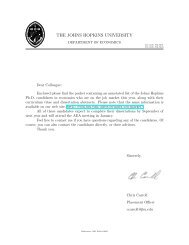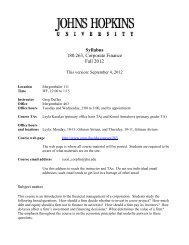WEALTH, DISPOSABLE INCOME AND CONSUMPTION - Economics
WEALTH, DISPOSABLE INCOME AND CONSUMPTION - Economics
WEALTH, DISPOSABLE INCOME AND CONSUMPTION - Economics
Create successful ePaper yourself
Turn your PDF publications into a flip-book with our unique Google optimized e-Paper software.
3 IS <strong>WEALTH</strong> USEFUL IN EXPLAINING<br />
<strong>CONSUMPTION</strong>?<br />
Reliable measures of aggregate human and non-human wealth are potentially<br />
useful for addressing a broad range of macro issues, but perhaps<br />
their most obvious application is in determining consumption and savings.<br />
Specifically, one might ask, is measured wealth useful in explaining the<br />
time-series behaviour of aggregate consumption?<br />
An alternative model with a long tradition in macroeconomics is the<br />
Keynesian consumption function that specifies consumption as a function<br />
of disposable income. The usefulness of wealth in explaining consumption<br />
is therefore evaluated relative to this alternative over both long and short<br />
horizons. The long-run analysis examines the relationship between consumption,<br />
wealth and disposable income using static linear regressions<br />
and standard tests for cointegration. This long-run analysis then serves as a<br />
precursor for the estimation of EC consumption equations designed to<br />
explain the short-run dynamics of consumption around its long-run trend.<br />
At the outset it is worth stressing that this approach to assessing the<br />
usefulness of wealth is relatively stringent, since the disposable-income<br />
and wealth-based consumption functions may be (nearly) observationally<br />
equivalent. If innovations in disposable income are permanent or at least<br />
very persistent, then most of the information regarding their future path,<br />
and thus the information embodied in human wealth, is contained in the<br />
current observations of disposable income. Indeed, using Monte Carlo simulations,<br />
Davidson and Hendry (1981) have shown that Hall’s (1978) random-walk<br />
model and the EC models developed by Davidson et al. (1978)<br />
and Hendry and von Ungern-Sternberg (1981) are nearly equivalent.<br />
Moreover, at a theoretical level, both Campbell (1987) and<br />
Mitchener (1984) have demonstrated that a cointegrating relationship<br />
between consumption and disposable income is consistent with the life<br />
cycle–permanent income model. The results below cannot, therefore, be<br />
viewed as definitive tests of the permanent income model. Rather, they<br />
address the more modest question: Does measured wealth provide<br />
23




